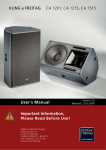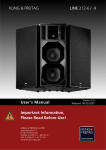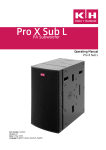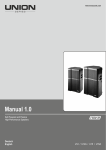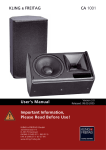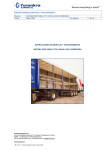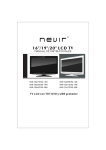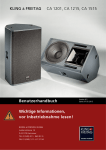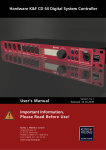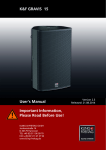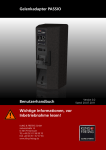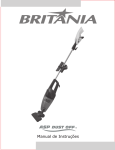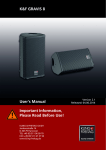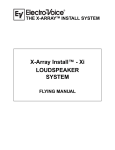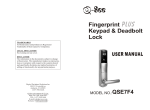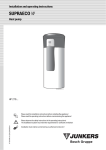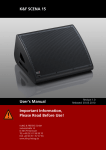Download CA 12XX_1515_en
Transcript
KLING & FREITAG CA 1201, CA 1215, CA 1515 User's Manual Important Information, Please Read Before Use! KLING & FREITAG GmbH Junkersstrasse 14 D-30179 Hannover PHONE 0 (049) 511- 969 97-0 FAX 0 (049) 511- 67 37 94 www.kling-freitag.de Version 4.1 Released: 17.02.2015 User's Manual KLING & FREITAG GMBH ©1998 --- 2015 CA 1201, CA 1215-6 /-9, CA 1515-6 /-9 Version 4.0, 17.02.2015 Page 2 of 54 User's Manual CA 1201, CA 1215-6 /-9, CA 1515-6 /-9 Thank you for your decision to buy a Kling & Freitag product. To guarantee a trouble-free operating of the equipment and to enable the KLING & FREITAG CA speaker system to achieve its full potential, please read the operating instructions carefully before use. With the purchase of a CA system, you have acquired a speaker system with the highest possible quality and performance capabilities. As the owner of this system, you now have a versatile and highly professional tool which, when operated properly, is a true pleasure to use. Symbols in User's Manual This symbol indicates the possibility of life-threatening danger and a health risk for persons. Not following these instructions may result in serious health problems including potentially fatal injuries. Warning This symbol indicates a possibly dangerous situation. Not following these instructions may cause minor injuries or cause property damage. Caution This symbol gives instructions for the proper use of the described products. Not following these instructions may cause malfunctions or property damage. Important Information about this User's Manual User's Manual CA 1201, CA 1215-6 /-9, CA 1515-6 /-9 Version 4.0, 17.02.2015 © by André Figula, Kling & Freitag GmbH, 1998 - 2015; all rights reserved. All specifications in this manual are based on information available at the time of publishing for the features and safety guidelines of the described products. Technical specifications, measurements, weights and properties are not guaranteed. The manufacturer reserves the right to make product alterations within legal provisions as well as changes to improve product quality. All persons who use the speaker system must have this guide and all further information for safe operations available to them during assembly, disassembly, and use. We appreciate any input with suggestions and improvements for this manual. Please send this to us at the following address: [email protected] or to: KLING & FREITAG GMBH Junkersstr.14 D-30179 Hannover Phone +49 (0) 511 - 96 99 70 Fax +49 (0) 511 - 67 37 94 KLING & FREITAG GMBH ©1998 - 2015 Version 4.0, 17.02.2015 Page 3 of 54 User's Manual CA 1201, CA 1215-6 /-9, CA 1515-6 /-9 Contents Chapter Page 1. 2. General Instructions for Using Speakers Product Descriptions and Versions 2.1 CA 1201 2.2 CA 1215-6 2.3 CA 1215-9 2.4 CA 1515-6 2.5 CA 1515-9 3. Important Notes for the Options ‘Outdoor’ and ‘Installation’ 3.1 ‘Installation’ 3.2 ‘Outdoor Mobile’ 3.3 ‘Outdoor Installation’ 4. Notes for Versions with ‘100V’ Option 4.1 Reasons for choosing Speakers with 100 V Transformers 4.2 Connecting Diagram of the 100V Speaker Inputs 5. Instructions for Suspending the Speakers 5.1 Using the ‘allsafe JUNGFALK’ Flying Points 6. Coverage Patterns of the CA Speakers 6.1 Changing the Coverage Pattern 7. Mounting Instructions for Speakers 7.1 Proper Arrangement of the Loudspeakers 7.2 Arrayed Speaker Systems (Cluster) 7.2.1 Horn not rotated 7.2.2 With rotated Horn 8. Wiring 8.1 Connecting the Speakon Connector to the Terminal 8.2 Avoiding Ground Loops 8.2.1 What is a Ground Loop? 8.2.2 Avoiding Ground Loops 9. Configurations and Connecting Diagrams 9.1 Operating the Systems without K&F System Controller 9.1.1 CA Systems in Full-Range Mode 9.1.2 Full Range Mode & Subwoofer with Crossover (XO) 9.2 Operations with K&F System Controller 10. Operating the Speakers 11. Crossovers 11.1 Wiring Diagram CA 1201 11.1.1 Version A 11.1.2 Version B 11.2 Wiring Diagram CA 1215-6 and CA 1215 -9 11.2.1 Version A 11.2.2 Version B 11.3 Wiring Diagram CA 1515-6 and CA 1515-9 11.3.1 Version A 11.3.2 Version B KLING & FREITAG GMBH ©1998 --- 2015 Version 4.0, 17.02.2015 6 8 8 9 10 11 12 13 13 13 13 14 14 14 15 18 19 19 20 20 21 21 22 23 23 24 24 24 25 25 25 26 27 27 28 28 28 29 30 30 31 32 32 33 Page 4 of 54 User's Manual CA 1201, CA 1215-6 /-9, CA 1515-6 /-9 Chapter Page 12. Touching Up Damage to Paint / Changing the Front Foam 13. Technical Specifications 13.1 CA 1201 13.2 CA 1215-6 13.3 CA 1215-9 13.4 CA 1515-6 13.5 CA 1515-9 14. Measuring Charts 14.1 CA 1201 14.2 CA 1215-6 14.3 CA 1215-9 14.4 CA 1515-6 14.5 CA 1515-9 15. Dimensions 15.1 CA 1201, CA 1215-6 and CA 1215-9 15.2 CA 1201-M, CA 1215-6-M and CA 1215-9-M 15.3 CA 1201, CA 1215-6 and CA 1215-9 with Option ‘Installation’ 15.4 CA 1515-6 and CA 1515-9 15.5 CA 1515-6 and CA 1515-9 with Option ‘Installation’ 16. Accessories for the CA Systems 18. Supplied Safety and Mounting Instructions for Speakers and Accessories KLING & FREITAG GMBH ©1998 - 2015 Version 4.0, 17.02.2015 33 34 34 35 36 37 38 39 39 41 43 45 47 49 49 49 50 51 51 52 Page 5 of 54 User's Manual CA 1201, CA 1215-6 /-9, CA 1515-6 /-9 1. General Instructions for Using Speakers Mounting the speakers To prevent injury, the speakers must be securely placed on the floor or secured to the wall according to the instructions on page 20 (Mounting Instructions for Speakers). Please note that speakers can move as a result of vibrations. To prevent them from falling from their mounted position, they must be secured properly. If the weight of the speaker exceeds 20 kg then it is necessary for two people to carry it. Warning Speakers may only be suspended or mounted to walls or ceilings by qualified personnel. The speakers must be hung by using at least two of the designated flying points. The same applies when lifting and aligning the speakers. Never use signal cables or power cords for suspending, aligning or securing the systems. When laying the connecting cables, make sure that nobody can trip. Never hang more than two speakers under one another without using the designated Kling & Freitag rigging equipment. Ensure that all installation connections comply with the applicable safety guidelines and that the size and strength are sufficient. Further instructions are in our user's manual for assembly equipment and in the general safety instructions for speakers and assembly equipment. For mobile and fixed installations, use only rigging equipment from KLING & FREITAG. Make sure to observe the included safety and mounting instructions for loudspeakers and accessories. Speakers and rigging equipment must be visually examined at regular intervals. If there are signs of wear, they must be replaced immediately. Furthermore, screwed connections of supporting parts must be checked routinely. Protecting the speakers / avoiding fire hazard In general, audio signals should not be overdriven. This may be caused by mixing consoles, equalizers, effect equipment, etc. and should be indicated on this equipment. When a power amplifier is overloaded at the output (clipping), then the amplifier should activate a clipping warning signal. Power amplifiers can also be overloaded at the input circuit without the amplifier signalling the clipping, i.e. when there is not sufficient headroom in the input circuit. We, therefore, recommend turning up the power amplifiers all the way and adjusting the level before the power amplifier in order to avoid overloading the input circuit. In any case, the signal must be reduced as soon as it sounds unnaturally distorted. To protect the speakers from being destroyed and to avoid fire hazard, they should only be operated with professional power amplifiers with the following specifications: − Integrated or preceding subsonic filter (approx. 30 Hz, min. 12 dB / octave) − integrated clipping limiter − for speaker models CA 1201 or CA 1215: maximum rated power 500W@8Ω (equivalent 1000W@4Ω) Warning − for speaker model CA 1515: maximum rated power 700W@8Ω (equivalent 1400W@4Ω) If you wish to use a speaker with a power amplifier which does not fulfil these specifications, then the speaker should be controlled using a Kling & Freitag system controller with limiter function. This is the only way overloading and the risk of fire can be avoided. The results of such a power amplifier defect cannot be avoided by the controller. If power amplifiers have power ratings lower than mentioned above, then it is imperative that a clipping limiter is used to protect the speaker even if it is used with a Kling & Freitag system controller. For damage caused by overloading or use with power amplifiers other than those recommended above, Kling & Freitag GmbH does not assume warranty and excludes liability for possible consequential damage. KLING & FREITAG GMBH ©1998 --- 2015 Version 4.0, 17.02.2015 Important Page 6 of 54 User's Manual CA 1201, CA 1215-6 /-9, CA 1515-6 /-9 The following signals may damage the speakers Important − Permanent high-pitched signals with high frequency, and continuous noise from feedback. − Permanently distorted signals with high power. − Noises, which occur when the amplifier is on while equipment is being connected, disconnected or switched on. Do not install speakers in any of the following places: − Where the speakers are permanently exposed to direct sunlight − Where the speakers are exposed to high moisture − Where the speakers are exposed to strong vibrations and dust. Damage caused by the speakers' magnetic fields Speakers are permanently surrounded by a magnetic field even when they are not operating. Therefore, during transport and placement of the speakers, it is important to ensure that there is always approx. 1 m between the speakers and magnetic data media and computer/video monitors. Preventing hearing damage To prevent the risk of hearing damage, avoid being too close to operating speakers, even if the volume level seems to be low enough. In general, volume levels over 90 dB can cause hearing damage. Caution KLING & FREITAG GMBH ©1998 - 2015 Version 4.0, 17.02.2015 Page 7 of 54 User's Manual CA 1201, CA 1215-6 /-9, CA 1515-6 /-9 2. Product Descriptions and Versions 2.1 CA 1201 Short description: 2-way full-range speaker system with 12" low-mid chassis and 1" high frequency driver on a rotatable 90° x 60° CD horn. Homogeneous coverage and constant directivity starting at 1.2 kHz. Integrated crossover with self-resetting protection circuit for low-mid and high frequency path. Enclosure: Trapezoidal enclosure with additional cluster angles, 15 mm birch plywood, highly resistant structured grey or black finish, internal mounting flange, 5 ‘allsafe JUNGFALK’ flying points, 2 butterfly handles, highly permeable, ball proof steel grille with exchangeable black acoustic foam. Optional versions: − CA 1201-M: Enclosure with additional monitor angle − CA 1201-100V: 100V version with 300 VA toroidal transformer − CA 1201 --- ‘Installation’ Version for fixed installations − CA 1201 --- ‘Outdoor Installation’ / ‘Outdoor Mobile’ Versions for outdoor use under roofs − CA 1201-SP: Version with integrated power amplifier technology (not for CA 1201-M) 'SP' speakers are shipped with a separate user's manual! − Special finish in RAL colours KLING & FREITAG GMBH ©1998 --- 2015 Version 4.0, 17.02.2015 Page 8 of 54 User's Manual CA 1201, CA 1215-6 /-9, CA 1515-6 /-9 2.2 CA 1215-6 Short description: 2-way high-performance speaker system with 12" low-mid chassis and 1.5" high frequency horn driver on a rotatable 65° x 50° CD horn. Homogeneous coverage and constant directivity starting at 1.2 kHz. Integrated crossover with self-resetting protection circuit for high frequency path, delay time and phase optimisation. Enclosure: Trapezoidal enclosure with additional cluster angles, 15 mm birch plywood, highly resistable structured grey or black finish, internal mounting flange, 5 ‘allsafe JUNGFALK’ flying points, 2 butterfly handles, highly permeable, ball proof steel grille with exchangeable black acoustic foam. Optional versions: − CA 1215-6-M: Enclosure with additional monitor angle − CA 1215-6 100V: 100V version with 300 VA toroidal transformer − CA 1215-6 - ‘Installation’ Version for fixed installations − CA 1215-6 - ‘Outdoor Installation’ / ‘Outdoor Mobile’ Versions for outdoor use under roofs − CA 1215-6-SP: Version with integrated power amplifier technology (not for CA 1215-6-M) 'SP' speakers are shipped with a separate user's manual! − Special finish in RAL colours KLING & FREITAG GMBH ©1998 - 2015 Version 4.0, 17.02.2015 Page 9 of 54 User's Manual 2.3 CA 1201, CA 1215-6 /-9, CA 1515-6 /-9 CA 1215-9 Short description: 2-way high-performance speaker system with 12" low-mid chassis and 1.5" high frequency driver on a rotatable 90° x 50° CD horn. Homogeneous coverage and constant directivity starting at 1.0 kHz. Integrated crossover with self-resetting protection circuit for high frequency path, delay time and phase optimisation. Enclosure: Trapezoidal enclosure with additional cluster angles, 15 mm birch plywood, highly resistant structured grey or black finish, internal mounting flange, 5 ‘allsafe JUNGFALK’ flying points, 2 butterfly handles, highly permeable, ball proof steel grille with exchangeable black acoustic foam. Optional versions: − CA 1215-9-M: Enclosure with additional monitor angle − CA 1215-9-100V: 100V version with 300 VA toroidal transformer − CA 1215-9 - ‘Installation’ Version for fixed installations − CA 1215-9 - ‘Outdoor Installation’ / ‘Outdoor Mobile’ Version for outdoor use under roofs − CA 1215-9-SP: Version with integrated power amplifier technology (not for CA 1215-9-M) 'SP' speakers are shipped with a separate user's manual! − Special finish in RAL colours KLING & FREITAG GMBH ©1998 --- 2015 Version 4.0, 17.02.2015 Page 10 of 54 User's Manual CA 1201, CA 1215-6 /-9, CA 1515-6 /-9 2.4 CA 1515-6 Short description: description : 2-way high-performance speaker system with 15" low-mid chassis and 1.5" high frequency driver on a rotatable 65° x 50° CD horn. Homogeneous coverage and constant directivity starting at 1.2 kHz. Integrated crossover with self-resetting protection circuit for chassis and crossover, delay time and phase optimisation. Enclosure: Trapezoidal enclosure with additional monitor and cluster angles, 15 mm birch plywood, highly resistant structured grey or black finish, internal mounting flange, 5 ‘allsafe JUNGFALK’ flying points, 2 butterfly handles, highly permeable, ball proof steel grille with exchangeable black acoustic foam, non-abrasive plastic feet. Optional versions: − CA 1515-6-100V: 100V version with 300 VA toroidal transformer − CA 1515-6 - ‘Installation’ Version for fixed installations − CA 1515-6 - ‘Outdoor Installation’ / ‘Outdoor Mobile’ Version for outdoor use under roofs − CA 1515-6-SP: Version with integrated power amplifier technology (not for 1515-9-M) 'SP' speakers are shipped with a separate user's manual! − Special finish in RAL colours KLING & FREITAG GMBH ©1998 - 2015 Version 4.0, 17.02.2015 Page 11 of 54 User's Manual 2.5 CA 1201, CA 1215-6 /-9, CA 1515-6 /-9 CA 1515-9 Short description: description: 2-way high-performance speaker system with 15" low-mid chassis and 1.5" high frequency driver on a rotatable 90° x 50° CD horn. Homogeneous coverage and constant directivity starting at 1.0 kHz. Integrated crossover with self-resetting protection circuit for chassis and crossover, delay time and phase optimisation. Enclosure: Enclosure: Trapezoidal enclosure with additional monitor and cluster angles, 15 mm birch plywood, highly resistant structured grey or black finish, internal mounting flange, 5 ‘allsafe JUNGFALK’ flying points, 2 butterfly handles, highly permeable, ball proof steel grille with exchangeable black acoustic foam, non-abrasive plastic feet. Optional versions: − CA 1515-9-100V: 100V version with 300 VA toroidal transformer − − CA 1515-6 - ‘Installation’ Version for fixed installations CA 1515-9 - ‘Outdoor Installation’ / ‘Outdoor Mobile’ Version for outdoor use under roofs − CA 1515-9-SP: Version with integrated power amplifier technology (not for 1515-9-M) 'SP' speakers are shipped with a separate user's manual! − Special finish in RAL colours KLING & FREITAG GMBH ©1998 --- 2015 Version 4.0, 17.02.2015 Page 12 of 54 User's Manual CA 1201, CA 1215-6 /-9, CA 1515-6 /-9 3. Important Notes for the Options ‘Outdoor’ and ‘Installation’ Speakers with the option ‘Outdoor Mobile’ and ‘Outdoor Installation’ have been optimised for outdoor use. They withstand temperature fluctuations in moderate climate zones and do not accumulate condensation water. In order to guarantee the longevity and safety of the speakers, the speakers with the option ‘Outdoor’ must still be protected from direct effects of the weather. Warning They should be installed, for example, under a roof so that they also have sufficient protection from driving rain from the side and direct sunlight. 3.1 ‘Installation’ Version for fixed indoor installations. Features like standard version but: − without feet and handles − seven stainless steel flying points with internal M10 threads, − stainless steel connecting terminal with single PG cable fitting, Ø 13 mm Connector: 1bl 3.2 2+ bn bl = blue bn = brown ‘Outdoor Mobile’ Version for mobile outdoor use under roofs. Features like standard version but with the following extras: − multi-layered, temperature and UV-resistant high-tech PU marine primer, − final coating with highly resistant structured 2K paint in RAL colours, − waterproofed diaphragms and electronic components protected against corrosion with protective coating. 3.3 ‘Outdoor Installation’ Version for fixed outdoor installations under roofs. Features like 'Outdoor Mobile', but: − without feet and handles. − seven stainless steel flying points with internal M10 threads − stainless steel grille − foam covering behind grille − visible screws made of stainless steel. − Stainless steel connecting terminal with single PG cable fitting, Ø 13 mm (connecting scheme see version ‘Installation’) KLING & FREITAG GMBH ©1998 - 2015 Version 4.0, 17.02.2015 Page 13 of 54 User's Manual CA 1201, CA 1215-6 /-9, CA 1515-6 /-9 4. Notes for Versions with ‘100V’ Option Kling & Freitag speakers with ‘100V’ option are fitted with high-quality toroidal transformers. This serves to minimize loss of sound. Highly professional sound reinforcement results can be achieved using 100 V Kling & Freitag speakers. 4.1 Reasons for choosing Speakers with 100 V Transformers − Reduction in conduction loss. − Easy installation of a loudspeaker network due to simple parallel wiring. The sum of the output power of the individual speakers (stated as VA = W) must not exceed the output power of the 100 V amplifier. − Speakers are galvanically isolated. − Speakers can be integrated into existing 100 V systems. 4.2 Important Connecting Diagram of the 100V Speaker Inputs 300VA transformer 300VA 1+ 2- IN 12+ 0 all pins parallel to out KLING & FREITAG GMBH ©1998 --- 2015 Version 4.0, 17.02.2015 Page 14 of 54 User's Manual CA 1201, CA 1215-6 /-9, CA 1515-6 /-9 5. Instructions for Suspending the Speakers The speakers may only be suspended by trained specialised personnel. Pay attention to the required safety factors. Please follow the accompanying safety and assembly instructions carefully as well as the corresponding national safety regulations. Warning All sound systems used are to be secured against toppling or falling in the manner required by the carriers of the statutory accident insurances for studio or stage areas. Appropriate directions can be found in BGV C1 or corresponding local national safety guidelines. Amongst other things, this regulation stipulates that mobile sound equipment must be secured from falling from two separate points. Because no clear regulations are available to us regarding fixed installations, as a precaution, we stipulate always using a second independent safety point to secure Kling & Freitag products. The equipment is to be secured using steel chains, ropes of steel wire, and similar materials, which are designed for the particular load and, when taking into consideration possible dynamic forces (i.e. during falling), are of sufficient size. The safety factors for the securing equipment as well as the maximum admissible falling height of 20 cm according to BGV C1, which are defined in the regulations and norms valid when this handbook was published, must be complied with. Ensure that all connections are secured to prevent their detaching on their own and that only admissible statically tested and sufficiently sized connecting devices, ropes and chains are used. The upper and bottom flying and securing point "VariPoints", the 'K&F eyebolt' and the 'K&F Lifting Pin' are suitable for securing a secondary safety device according to the German safety regulations BGV C1. The rear 'Varipoint' are only suitable for a bracing of the loudspeaker. Please heed the following specifications: wire length wire diameter max. falling height Wire rope according to DIN EN 56927 1m 5mm 0.2m Major Saveking® safety wire 0.6m 3mm 0.2m KLING & FREITAG GMBH ©1998 - 2015 Version 4.0, 17.02.2015 Page 15 of 54 User's Manual CA 1201, CA 1215-6 /-9, CA 1515-6 /-9 1.1 Example 1: Rigging with K&F Adjustable Speaker Mount or K&F Ceiling Bracket The letters with numbers indicate the particular fastening points, the numbers define the necessary first and second rigging points, accordingly. A1 and A2 = required 2 rigging points, connection speaker to inner bracket B1 and B2 = required 2 rigging points, connection inner bracket to outer bracket C1 and C2 = required 2 rigging points, connection outer bracket to cross beam If the safety wire C2 is missing, then the requirement to have two independently acting pieces of equipment to prevent falling is not fulfilled! C1 A1 B1 C1 A2 A1 B2 C2 A2 B1 B2 2.1 Example 2: Rigging without K&F Adjustable Speaker Mount or K&F Ceiling Bracket with additional loudspeaker Speaker systems, whether single or connected to one another, must always be secured to a second separate point, even if two rigging points are used for suspending the speaker system! Ensure that all connections are secured to prevent their detaching on their own and that only admissible statically tested and sufficiently sized connecting devices, ropes and chains are used. A rigging with only one safety device is prohibited. A safety at a rear suspension is prohibited. The rear suspension point can only be used for bracing the speaker. KLING & FREITAG GMBH ©1998 --- 2015 Version 4.0, 17.02.2015 Warnung Page 16 of 54 User's Manual CA 1201, CA 1215-6 /-9, CA 1515-6 /-9 Wrong: • The suspended speaker weighs more than 50 kg. This exceeds the total load-bearing capacity of the upper flying points. As a result, a maximum of 2 full-range systems may be suspended under one another. • The rear suspension point can only support weights up to 30 kg. The flying point is thus not an appropriate secondary device to prevent collapse if another speaker is mounted. • The angle of the rope/chain in relation to the top of the mounted speaker is less than 45°. This causes the load on the flying points to exceed the permissible level. Right: • A two-point suspension was selected. Each speaker is secured with an additional safety device. • The suspended speaker weighs no more than 50 kg. This falls within the total load-bearing capacity of the upper flying point. • The angle of the rope/chain in relation to the top of the mounted speaker is greater than 45°. This maintains a permissible load on the flying points. KLING & FREITAG GMBH ©1998 - 2015 Version 4.0, 17.02.2015 Page 17 of 54 User's Manual 5.1 CA 1201, CA 1215-6 /-9, CA 1515-6 /-9 Using the ‘allsafe JUNGFALK’ Flying Points Single Stud Fitting Used as fastener to the ‘allsafe JUNGFALK’ flying point. 1.) ‘allsafe JUNGFALK’ flying point Receptacle for special fasteners. 2.) Take the single stud fitting in one hand... 3.) ... and push the locking device up against the spring tension. 4.) Put the flat head of the holding bolt into the guiding of the flying point. Release the locking device when the single stud fitting is located in the middle of the flying point. Make sure that the locking device clicks into place. 5.) Warning Check that the single stud fitting is securely fastened and cannot be pulled out. KLING & FREITAG GMBH ©1998 --- 2015 Version 4.0, 17.02.2015 Page 18 of 54 User's Manual CA 1201, CA 1215-6 /-9, CA 1515-6 /-9 6. Coverage Patterns of the CA Speakers The mid-high systems can be operated in a vertical or horizontal (i.e. as a stage monitor) position. The coverage pattern of the speakers can be adapted to special needs by a 90° rotatable horn. The table below shows the coverage angles of a standing speaker: To determine the coverage pattern of the high frequency horn, shine a flashlight through the front covering at the level of the horn. You will find a silver stripe that determines the position and coverage angles of the horn. DEFINITI DEFINIT I ON: Standing speaker: Horn not rotated Horn rotated 90° h x 60° v 65° h x 50° v 90° h x 50° v 65° h x 50° v 90° h x 50° v 60° h x 90° v 50° h x 65° v 50° h x 90° v 50° h x 65° v 50° h x 90° v Model CA 1201 CA 1215-6 CA 1215-9 CA 1515-6 CA 1215-9 6.1 Changing the Coverage Pattern To turn the horn, follow these steps: 1) Remove the four grille mounting screws on the top and bottom of the speakers with a 3 mm Allen key and remove the grille from the speaker enclosure. 2) Remove the screws from the high frequency horn (also using a 3 mm Allen key). Loosen the high frequency horn by using both hands, palms to the outside, to grasp into the horn and lift the horn with even pressure from the palms of your hands towards the outside. Should the horn adhere to the foam rubber attached below, release it using a screwdriver or something similar to gently lever it up. 3) Rotate the horn 90° and screw the horn on tightly again (do not force it!). 4) Screw the grille on tightly. If the coverage angle needs to be changed often, make sure that the horn is not always rotated in the same direction, as the connecting cables, when twisted, may cause the contacts of the driver to become loose. KLING & FREITAG GMBH ©1998 - 2015 Version 4.0, 17.02.2015 Page 19 of 54 User's Manual CA 1201, CA 1215-6 /-9, CA 1515-6 /-9 7. Mounting Instructions for Speakers Mount the speakers securely. To avoid injury or damage, always be sure to mount the speakers securely so that they do not fall. Speakers, which are stacked, must be secured with securing straps. When laying the connecting cables, make sure that nobody can trip. The stability of stacked systems (also valid for the use of stands and distance rods!) is contingent upon the following stability requirement. These conditions must, therefore, be guaranteed by the user: Warning Stacked systems may not fall over even if they are inclined by 10° in each direction. If this requirement is not fulfilled, then it is necessary to take steps to achieve compliance. Possible measures include strapping it to an appropriate base structure or fastening it using safety straps. 7.1 Proper Arrangement of the Loudspeakers Be aware of the fact that the logical targeted alignment of this high quality speaker system can lead to a significant qualitative increase in the acoustic result. It is not possible to make generalities about the alignment of specific systems because the room has a substantial influence on the signal and the audible result. As a rule, the mid- and high-transducers of loudspeakers should be mounted above the audience's face value, so that the sound distribution cannot be shadowed. In many cases it is advisable to mount a loudspeaker higher, so that the sound will be distributed throughout the room more evenly. Low standing systems result in a greater difference in volume between front and back seats than higher standing systems. Please note that this is only a general guideline and the best possible result may vary from room to room. To simulate the correct alignment of the speakers beforehand, there are various programs such as ‘Ease’ or ‘Ulysses’. The Kling & Freitag speaker system data is available for download on our website www.kling-freitag.de. The following graphics will assist in making a rough estimate as to the distance range of full-range systems. The graphics only take into consideration the sum of the direct sound and not the influence of the room. Because of this there can, in some cases, be noticeable deviation. Distance range of SPL (direct sound level): -18 dB -12 dB -6 dB -24 dB 0 dB 2m 4m 8m -34 dB -30 dB 16m KLING & FREITAG GMBH ©1998 --- 2015 32m Version 4.0, 17.02.2015 50m Page 20 of 54 User's Manual CA 1201, CA 1215-6 /-9, CA 1515-6 /-9 7.2 Arrayed Speaker Systems (Cluster) If the loudspeakers are operated through the optional K&F System Controller, we recommend to turn on the 'Top Low Cut' filter for clustered operation. Thus the frequency response for this application can be optimised (see also user’s manual of the K&F System Controller). When operating the systems without a K&F System Controller in a clustered configuration, the signal level of frequencies below 300 Hz should be reduced by 3-4 dB. 7.2.1 Horn not rotated Winkel 2 Horn not rotated Winkel 3 Standing speaker A smaller angle 3 results in a smaller vertical coverage angle but increases the sound power level. Winkel 1 Combination CA 1201 with CA 1201 CA 1215-6 with CA 1215-6 CA 1215-6 with CA 1215-9 CA 1215-9 with CA 1215-9 CA 1515-6 with CA 1515-6 CA 1515-6 with CA 1515-9 CA 1515-9 with CA 1515-9 Application between the sides of the speakers between middle axes Angle 1 45°-55° Angle 2 55°-65° not generally recommended* not generally recommended* 30° 40° 35° 45° 40°-50° 50°-60° not generally recommended* not generally recommended* 30° 40° 35° 45° 40°-50° 50°-60° not generally recommended* not generally recommended* Angle 3 20°-35 20°-30° Increasing the horizonIncreasing the Increasing the vertical tal coverage angle, e.g. horizontal cover- coverage angle, e.g. for wide audience age angle and for covering balcoplanes sound power level nies or for increased for larger distancsound power level es for larger distances *If several 90° systems are clustered, unwanted interference effects may appear. As a result, we do not generally recommend clustered configurations of CA 1201, CA 12159 and CA 1515-9 systems. If wide angles are to be covered, we recommend the use of several 60° or 65° systems in one cluster. KLING & FREITAG GMBH ©1998 - 2015 Version 4.0, 17.02.2015 Page 21 of 54 User's Manual CA 1201, CA 1215-6 /-9, CA 1515-6 /-9 7.2.2 With rotated Horn Winkel 2 Horn rotated Winkel 3 Standing speaker A smaller angle 3 results in a smaller vertical coverage angle but increases the sound power level. Winkel 1 Combination CA 1201 with CA 1201 CA 1215-6 with CA 1215-6 CA 1215-6 with CA 1215-9 CA 1215-9 with CA 1215-9 CA 1515-6 with CA 1515-6 CA 1515-6 with CA 1515-9 CA 1515-9 with CA 1515-9 Application Angle 1 Angle 2 Angle 3 25° 35° Not recommended 30°-40° 30°-45° 20° 30° Not recommended 30°-40° 30°-45° Not recommended Increasing the horizon- Increasing the hori- Increasing the vertital coverage angle, e.g. zontal coverage cal coverage angle, for wide audience angle and sound e.g. for covering planes power level for balconies or for larger distances increased sound power level for larger distances KLING & FREITAG GMBH ©1998 --- 2015 Version 4.0, 17.02.2015 Page 22 of 54 User's Manual CA 1201, CA 1215-6 /-9, CA 1515-6 /-9 8. Wiring The speaker is equipped with two parallel Speakon connectors. Make sure that all units are switched off and all controls are turned down before connecting your CA systems. − We recommend the use of high-quality speaker cables provided by KLING & FREITAG. − For connections to the power amplifier inputs, please use 2-pin shielded microphone cable with high-quality connectors. − Avoid ground loops (see chapter 8.2 ) − Please pay attention to the respective pin diagrams in this manual! − Make sure that the +/- polarity of the speakers at the amplifier is correct. When simultaneously using power amplifiers from different manufacturers, be sure to use the correct specific pin configuration. It may be necessary to modify the pin configuration on the power amplifiers or on the connectors leading to them. − Upon completing the wiring, ensure that the connected speaker channels are working in phase. To do so, use i.e. a phase checker. A phase error can also be recognized when the connected channels are used simultaneously. During simultaneous use the bass frequencies become notably quieter or the mid-frequencies such as voices cannot be located. − To avoid loss of power, the cables should have a minimum wire gauge of 2.5 mm² more for longer cabled distances. A minimum wire gauge can be easily calculated with the following formula: Important Minimum Wire Gauge (mm²) = Required Cable Length (m) 2 x Speaker Impedance (Ω) If several loudspeakers are connected, the signal can be linked through from one loudspeaker to the next. Please make sure that the total impedance of the loudspeakers R(Ω) is not lower than the minimal impedance indicated on the power amplifier. 1/R1 + 1/R2 + 1/R3 + ... = 1/Rtotal 8.1 Connecting the Speakon Connector to the Terminal 1. 2. 2. 3. 1. KLING & FREITAG GMBH ©1998 - 2015 Version 4.0, 17.02.2015 Page 23 of 54 User's Manual 8.2 CA 1201, CA 1215-6 /-9, CA 1515-6 /-9 Avoiding Ground Loops 8.2.1 What is a Ground Loop? Every component of a P.A. or Hi-Fi System has its own internal 0 V reference (ground). This point is often connected to the protective earth connector (PE / Ground). If two or more units are connected to one another with a line level audio cable, there may be a ground connection through the ground of the power supply cable (yellow-green) as well as through the shielding of the audio cable. The voltage difference between these two ground points causes audible interference to come from the speaker 8.2.2 Avoiding Ground Loops If there is a loud humming or buzzing after the CA System has been connected, then check that a "ground loop" has not been built into the system. Some power amplifiers and system controllers are equipped with a "Ground Lift" switch. Set these switches to the "Lift" position one after the other. If the noise is still audible, check if, 1. the noise is caused by a ground loop before the power amplifiers / controllers (e.g. mixing console, effects or equalizers). 2. the system or parts of the system are connected to an "unclean" power supply - meaning one, which is also running large motors, or lighting systems. An "unclean" supply voltage, electrostatic and electromagnetic fields can cause a malfunction. Please observe the following basic rules: − Never!!! try to avoid a ground loop by disconnecting or taping the ground contact at the power connector! Extremely dangerous! − If possible, only use high-quality audio appliances with balanced signal outputs and with power cables with PE connectors. − − Use high-quality cables with good shielding. The point of ground for all connected components should merge at one central point. The power connections should lead out in a radial manner from one point and not be linked from one unit to the next. − When installing appliances that create strong electrostatic or electromagnetic fields (large transformers, switch-mode power supplies), maintain some distance from other audio appliances. In extreme cases, the only solution is to create a completely independent "audio ground"; in other cases, it is sufficient to connect a filter in front of the audio equipment. KLING & FREITAG GMBH ©1998 --- 2015 Version 4.0, 17.02.2015 Warning Page 24 of 54 User's Manual CA 1201, CA 1215-6 /-9, CA 1515-6 /-9 9. Configurations and Connecting Diagrams 9.1 Operating the Systems without K&F System Controller The full-range systems can be used alone or in conjunction with a K&F subwoofer with integrated crossover (e.g. SW 112-XO / SW 115D-XO SW 115E-XO or SW 118E-XO). In this mode of operation the crossover limits the subwoofer's frequency range. To protect the speakers from being destroyed and to avoid fire hazard, they should only be operated with professional power amplifiers with the following specifications: − integrated or preceding subsonic filter (approx. 30 Hz, min. 12 dB / octave) − integrated clipping limiter − for speaker model CA 1201 or CA 1215: maximum rated power 500W@8Ω (equivalent 1000W@4Ω) − for speaker model CA 1515: maximum rated power 700W@8Ω (equivalent 1400W@4Ω) If you wish to use a speaker with a power amplifier which does not fulfil these specifications, then the speaker should be controlled using a Kling & Freitag System Controller with limiter function. This is the only way overloading and the risk of fire can be avoided. The results of such a power amplifier defect cannot be avoided by the controller. Warning 9.1.1 CA Systems in Full-Range Mode This mode of operation is ideal for speech applications and music applications without the need for a high bass content. Should more bass be needed, the bass level can be increased between 50 and 80 Hz at the mixing console. INPUT e.g. from mixer, AUX or Connector Panel OUTPUTS INPUT CH 2 INPUT CH 1 + CH 2 - + CH 1 If you are operating a mid-high system in a cluster (speakers arranged in close proximity) or as a stage monitor, reduce the frequencies below 300 Hz by 3-4 dB! (The K&F System Controllers have a special ‘Top Low Cut’ filter function for this purpose.) KLING & FREITAG GMBH ©1998 - 2015 Version 4.0, 17.02.2015 Page 25 of 54 User's Manual CA 1201, CA 1215-6 /-9, CA 1515-6 /-9 9.1.2 Full Range Mode & Subwoofer with Crossover (XO) In this mode of operation you can easily realise applications, where a higher bass level is needed. In this mode of operation be sure to use only amplifiers, which can handle speaker impedances down to 3 Ω. Recommended combinations of CA systems, as described here, with K&F subwoofers: Important 2 CA systems + 2- 4 x SW 112-XO 2 x SW 115D-XO 2 x SW 115E-XO 1 - 2 x SW 118E-XO Switch To 'XO ON' Switch To 'XO ON' INPUT e.g. from mixer, AUX or Connector Panel OUTPUTS INPUT CH 2 INPUT CH 1 + - CH 2 + CH 1 The switch ‘XO’ on the connecting terminal of the subwoofer must be at XO ‘ON’ for this mode of operation: Switch on the subwoofer’s connecting terminal When using the mid-high systems in a cluster (speakers in close proximity), reduce the frequencies below 300 Hz by 3-4 dB. (The K&F System Controllers have a special ‘Top Low Cut’ filter function for this purpose.) KLING & FREITAG GMBH ©1998 --- 2015 Version 4.0, 17.02.2015 Page 26 of 54 User's Manual CA 1201, CA 1215-6 /-9, CA 1515-6 /-9 9.2 Operations with K&F System Controller For optimal performance and operating safety we recommend using a K&F system controller. Instructions for use, connecting diagrams and detailed descriptions of the latest controller models ‘CD 24’ and ‘CD 44’ you can find in the corresponding user’s manuals. 10. Operating the Speakers − Switch off all equipment and turn down all level controls. − Wire your CA systems. Important − Pay attention to the user’s manuals of your power amplifiers. − Upon completing the wiring, ensure that the connected speaker channels are working in phase. To do so, use i.e. a phase checker. A phase error can also be recognized when the connected channels are used simultaneously. During simultaneous use the bass frequencies become notably quieter or the mid-frequencies such as voices cannot be located. − Now switch on the peripheral equipment first (mixing console, effects etc.), followed by the K&F system controller, if used, and the power amplifiers. Always use the before mentioned switching order. Otherwise switching noises may damage the system. − If there is interference, turn off all appliances in the reverse order and check all cable − connections. Successively turn up the individual power amplifier channels and send a signal with low volume to the system. Check to see if the desired signals are applied to the intended speakers and make sure there is no interference. Make sure everything works properly, i.e. if the signals come from the correct speaker paths (high signals from the tweeters, bass signals from the bass speaker). Your system should now be ready for operation. − Turning down the input level controls may not always prevent distortions in the input section of the power amplifier, especially if this section has a relatively low headroom. A clipping signal may not be displayed by the clipping indicator then. To prevent signal interruptions from protection circuits or damages to the speakers, turn the level controls of the power amplifier to the maximum position, if possible. The output level of the mixing console or the controller should be set to a level that doesn't overload the power amplifiers. − When turning off the system, the input controls for the power amplifiers should be turned down first followed by the power switches of the amplifiers. After that, the other appliances can be turned off. − The crossovers of the CA systems are equipped with protection circuits for the high frequency driver and the crossover itself. These circuits cut off the signal current when highly overloaded. If the high speaker turns off, reduce the volume. After a few seconds, it will turn back on automatically. KLING & FREITAG GMBH ©1998 - 2015 Version 4.0, 17.02.2015 Page 27 of 54 User's Manual CA 1201, CA 1215-6 /-9, CA 1515-6 /-9 11. Crossovers 11.1 Wiring Diagram CA 1201 The crossover networks as of the end of 2003 differ from earlier models. Please compare the crossover built into your speaker with the figures below and wire accordingly: 11.1.1 Version A CA 1201 & CA 1201-M up to serial no. 231 0000 20 29 (by the end of October 03) Pin assignment Speakon NL4 + - / / ‘IN’ 1+ 1- 2+ 2- ‘OUT’ parallel with ‘IN’ KLING & FREITAG GMBH ©1998 --- 2015 Version 4.0, 17.02.2015 Page 28 of 54 User's Manual CA 1201, CA 1215-6 /-9, CA 1515-6 /-9 11.1.2 Version B CA 1201 & CA 1201-M from serial no. 231 0000 20 30 (as of the end of October 03) + - HF Pin assignment Speakon NL4 + - / / ‘IN’ 1+ 1- ‘OUT’ parallel with ‘IN’ KLING & FREITAG GMBH ©1998 - 2015 2+ 2- Version 4.0, 17.02.2015 Page 29 of 54 User's Manual CA 1201, CA 1215-6 /-9, CA 1515-6 /-9 11.2 Wiring Diagram CA 1215-6 and CA 1215 -9 The crossover networks as of the end of 2003 differ from earlier models. Please compare the crossover built into your speaker with the figures below and wire accordingly. 11.2.1 Version A CA 1215-6 and CA 1215-6-M up to serial number 23090007055 (before Sept. 03) CA 1215-9 and CA 1215-9-M up to serial number 23090002675 (before Sept. 03) IN + / link to XO 2 IN - / Link to XO 2 + LF - - + HF - XO 2 IN - IN + Pin assignment Speakon NL4 + - / / ‘IN’ 1+ 1- 2+ 2- ‘OUT’ parallel with ‘IN’ KLING & FREITAG GMBH ©1998 --- 2015 Version 4.0, 17.02.2015 Page 30 of 54 User's Manual CA 1201, CA 1215-6 /-9, CA 1515-6 /-9 11.2.2 Version B CA 1215-6 and CA 1215-6-M from serial number 23090007056 up (as of Sept. 03) CA 1215-9 and CA 1215-9-M from serial number 23090002676 up (as of Sept. 03) IN + / link to XO 2 IN - / Link to XO 2 XO 1 + - LF XO 2 HF + HF - HF + Pin assignment Speakon NL4 + - / / ‘IN’ 1+ 1- ‘OUT’ parallel with ‘IN’ KLING & FREITAG GMBH ©1998 - 2015 2+ 2- Version 4.0, 17.02.2015 Page 31 of 54 User's Manual CA 1201, CA 1215-6 /-9, CA 1515-6 /-9 11.3 Wiring Diagram CA 1515-6 and CA 1515-9 The crossover networks as of the end of 2003 differ from earlier models. Please compare the crossover built into your speaker with the figures below and wire accordingly. 11.3.1 Version A CA 1515-6 and CA 1515-9 up to serial number 23116000434 (before November 03) XO 1 LF + + IN + / link to XO 2 LF LF - IN - / Link to XO 2 HF - HF + HF + XO 2 IN + IN - Pin assignment Speakon NL4 + - / / ‘IN’ 1+ 1- 2+ 2- ‘OUT’ parallel with ‘IN’ KLING & FREITAG GMBH ©1998 --- 2015 Version 4.0, 17.02.2015 Page 32 of 54 User's Manual CA 1201, CA 1215-6 /-9, CA 1515-6 /-9 11.3.2 Version B CA 1515-6 and CA 1515-9 from serial number 23116000435 (as of November 03) IN + / link to XO 2 IN - / Link to XO 2 + - LF HF + Pin assignment Speakon NL4 + - / / ‘IN’ 1+ 1- 2+ 2- ‘OUT’ parallel with ‘IN’ 12. Touching Up Damage to Paint / Changing the Front Foam Although the PU structured paint used by KLING & FREITAG is impact proof and extremely resistant, we recommend using protective coverings or cases to help avoid damaging the paint during i.e. continuous mobile use. If paint damage occurs despite these precautions, it can be touched up by using commercial acrylic paint in the appropriate RAL colour of the speaker. To replace the filter foam, send the front grille incl. foam to KLING & FREITAG GmbH. Upon payment for expenses, the grille with the new covering will be returned. KLING & FREITAG GMBH ©1998 - 2015 Version 4.0, 17.02.2015 Page 33 of 54 User's Manual CA 1201, CA 1215-6 /-9, CA 1515-6 /-9 13. Technical Specifications 13.1 CA 1201 Loudspeaker Design 2-way passive system, bass reflex tuning Frequency range -10 dB 54 Hz - 19 kHz Frequency range ±3 dB 65 Hz - 18 kHz Coverage angles nominal 90° x 60° (hor. x vert.) Directivity index (DI) 10 (+1.5/-1) 1.2 kHz - 16 kHz Power handling 300 W nominal Max. SPL 126 dB (SPL peak / 1 m) Components 12‘‘ low-mid chassis 1) 1" high freq. driver with 40 mm titanium dome on rotatable CD-horn Crossover 1.8 kHz 18 dB / octave self-resetting protection circuits for 12‘‘ and 1‘‘ chassis Impedance (nominal) 8Ω Connectors 2 x Speakon NL4MP (1+ / 1-) Enclosure Trapezoidal enclosure with additional cluster angles, 15 mm Finnish birch Multiplex with highly resistant black structured paint (PU), 2 butterfly handles, mounting flange K&M 19656, ball proof front grille with exchangeable black acoustic foam Rigging 5 flying points 'allsafe JUNGFALK' Dimensions (W x H x D) 380 x 605 x 375 mm Weight 25 kg Options '48° monitor angle’ (K&F CA 1201 - M) '100 Volt with 300 VA toroidal transformer’ ‘Barrier strip instead of Speakon connectors' 'Outdoor Mobile' and 'Outdoor Installation' ‘Special finish in RAL colours’ Accessories see catalogue or visit www.kling-freitag.de KLING & FREITAG GMBH ©1998 --- 2015 Version 4.0, 17.02.2015 Page 34 of 54 User's Manual CA 1201, CA 1215-6 /-9, CA 1515-6 /-9 13.2 CA 1215-6 Loudspeaker Design 2-way passive system, bass reflex tuning Frequency range -10 dB 62 Hz - 22 kHz Frequency range ±3 dB 84 Hz - 19 kHz Coverage angles nominal 65° x 50° (hor. x vert.) Directivity index (DI) 12 (+1.5/-2) 1.2 kHz - 16 kHz Power handling 400 W nominal Max. SPL 130 dB (SPL peak / 1 m) Components 12‘‘ low-mid chassis 1) 1.5‘‘ high freq. driver with 75 mm titanium dome on rotatable CD-horn Crossover 1.2 kHz 12 dB / octave, self-resetting protection circuits for 12‘‘ and 1.5‘‘ chassis, all-pass filter for delay time and phase optimisation Impedance (nominal) 8Ω Connectors 2 x Speakon NL4MP (1+ / 1-) Enclosure Trapezoidal enclosure with additional cluster angles, 15 mm Finnish birch Multiplex with highly resistant black structured paint (PU), 2 butterfly handles, mounting flange K&M 19656, ball proof front grille with exchangeable black acoustic foam Rigging 5 flying points 'allsafe JUNGFALK' Dimensions (W x H x D) 380 x 605 x 375 mm Weight 31 kg Options '48° monitor angle’ (K&F CA 1215-6 - M) '100 Volt with 300 VA toroidal transformer’ ‘Barrier strip instead of Speakon connectors' 'Outdoor Mobile' and 'Outdoor Installation' ‘Special finish in RAL colours’ Accessories KLING & FREITAG GMBH ©1998 - 2015 see catalogue or visit www.kling-freitag.de Version 4.0, 17.02.2015 Page 35 of 54 User's Manual CA 1201, CA 1215-6 /-9, CA 1515-6 /-9 13.3 CA 1215-9 Loudspeaker Design 2-way passive system, bass reflex tuning Frequency range -10 dB 58 Hz - 22 kHz Frequency range ±3 dB 80 Hz - 19 kHz Coverage angles nominal 90° x 50° (hor. x vert.) Directivity index (DI) 10 (+2/-1) 1 kHz - 13 kHz Power handling 400 W nominal Max. SPL 129 dB (SPL Peak / 1 m) Components 12‘‘ low-mid chassis 1) 1.5‘‘ high freq. driver with 75 mm titanium dome on rotatable CD-horn Crossover 1.2 kHz 12 dB / octave, self-resetting protection circuits for 12‘‘ and 1.5‘‘ chassis, all-pass filter for delay time and phase optimisation Impedance (nominal) 8Ω Connectors 2 x Speakon NL4MP (1+ / 1-) Enclosure Trapezoidal enclosure with additional cluster angles, 15 mm Finnish birch Multiplex with highly resistant black structured paint (PU), 2 butterfly handles, mounting flange K&M 19656, ball proof front grille with exchangeable black acoustic foam Rigging 5 flying points 'allsafe JUNGFALK' Dimensions (W x H x D) 380 x 605 x 375 mm Weight 31 kg Options '48° monitor angle’ (K&F CA 1215-9 - M) '100 Volt with 300 VA toroidal transformer’ ‘Barrier strip instead of Speakon connectors' 'Outdoor Mobile' and 'Outdoor Installation' ‘Special finish in RAL colours’ Accessories see catalogue or visit www.kling-freitag.de KLING & FREITAG GMBH ©1998 --- 2015 Version 4.0, 17.02.2015 Page 36 of 54 User's Manual CA 1201, CA 1215-6 /-9, CA 1515-6 /-9 13.4 CA 1515-6 Loudspeaker Design 2-way passive system, bass reflex tuning Frequency range -10 dB 47 Hz - 22 kHz Frequency range ±3 dB 77 Hz - 19 kHz Coverage angles nominal 65° x 50° (hor. x vert.) Directivity index (DI) 12 (+1.5/-2) 1.2 kHz - 16 kHz Power handling 500 W nominal Max. SPL 132 dB (SPL peak / 1 m) Components 15‘‘ low-mid chassis 1) 1.5‘‘ high freq. driver with 75 mm titanium dome on rotatable CD-horn Crossover 1.1 kHz 12 dB / octave, self-resetting protection circuits for speakers and crossover, all-pass filter for delay time and phase optimisation Impedance (nominal) 8Ω Connectors 2 x Speakon NL4MP (1+ / 1-) Enclosure Multi-purpose enclosure with monitor and cluster angles, 15 mm Finnish birch Multiplex with highly resistant black structured paint (PU), 2 butterfly handles, mounting flange K&M 19656, ball proof front grille with exchangeable black acoustic foam Dimensions (W x H x D) 433 x 680 x 410 mm Weight 36.4 kg Options '100 Volt with 300 VA toroidal transformer’ ‘Barrier strip instead of Speakon connectors' 'Outdoor Mobile' and 'Outdoor Installation' ‘Special finish in RAL colours’ Accessories KLING & FREITAG GMBH ©1998 - 2015 see catalogue or visit www.kling-freitag.de Version 4.0, 17.02.2015 Page 37 of 54 User's Manual CA 1201, CA 1215-6 /-9, CA 1515-6 /-9 13.5 CA 1515-9 Loudspeaker Design 2-way passive system, bass reflex tuning Frequency range -10 dB 58 Hz - 22 kHz Frequency range ±3 dB 75 Hz - 19 kHz Coverage angles nominal 90° x 50° (hor. x vert.) Directivity index (DI) 10 (+2/-1) 1 kHz - 13 kHz Power handling 500 W nominal Max. SPL 131 dB (SPL peak / 1 m) Components 15‘‘ low-mid chassis 1) 1.5‘‘ high freq. driver with 75 mm titanium dome on rotatable CD-horn Crossover 1.1 kHz 12 dB / octave, self-resetting protection circuits for speakers and crossover, all-pass filter for delay time and phase optimisation Impedance (nominal) 8Ω Connectors 2 x Speakon NL4MP (1+ / 1-) Enclosure Multi-purpose enclosure with monitor and cluster angles, 15 mm Finnish birch Multiplex with highly resistant black structured paint (PU), 2 butterfly handles, mounting flange K&M 19656, ball proof front grille with exchangeable black acoustic foam Rigging 5 flying points 'allsafe JUNGFALK' Dimensions (W x H x D) 433 x 680 x 410 mm Weight 36.4 kg Options '100 Volt with 300 VA toroidal transformer ‘Barrier strip instead of Speakon connectors' 'Outdoor Mobile' and 'Outdoor Installation' ‘Special finish in RAL colours’ Accessories see catalogue or visit www.kling-freitag.de KLING & FREITAG GMBH ©1998 --- 2015 Version 4.0, 17.02.2015 Page 38 of 54 User's Manual CA 1201, CA 1215-6 /-9, CA 1515-6 /-9 14. Measuring Charts 14.1 CA 1201 Frequency response Impedance Frequency response 100 100 90 31.6 80 10 70 20 100 1000 Frequency (Hz) 10000 Impedance (Ohm) SPL (dB) 110 3,16 20000 Horizontal Vertical Beamwidth 360 -6dB Beamwidth (degrees) 300 240 180 120 60 0 20 100 1000 Frequency (Hz) 10000 20000 20 100 10 10 0 20 KLING & FREITAG GMBH ©1998 - 2015 100 1000 Frequency (Hz) Version 4.0, 17.02.2015 10000 Directivity Factor (Q) Directivity Index DI (dB) Directivity 1 20000 Page 39 of 54 User's Manual CA 1201, CA 1215-6 /-9, CA 1515-6 /-9 Horizontal coverage 180° 150° 120° 90° 60° 30° 0° -30° -60° Attenuation (dB) <3 3-6 6-9 9 - 12 -90° 12 - 15 -120° 15 - 18 -150° > 18 -180° 125 250 500 1k 2k 4k 8k 16K f [Hz] Vertical coverage 180° 150° 120° 90° 60° 30° 0° -30° Attenuation (dB) <3 3-6 6-9 -60° 9 - 12 -90° 12 - 15 -120° 15 - 18 -150° -180° 125 250 500 1k 2k 4k 8k > 18 16K f [Hz] KLING & FREITAG GMBH ©1998 --- 2015 Version 4.0, 17.02.2015 Page 40 of 54 User's Manual CA 1201, CA 1215-6 /-9, CA 1515-6 /-9 14.2 CA 1215-6 Frequency response Impedance Frequency response 100 100 90 31.6 80 10 70 20 100 1000 Frequency (Hz) 10000 Impedance (Ohm) SPL (dB) 110 3,16 20000 Horizontal Vertical Beamwidth 360 -6dB Beamwidth (degrees) 300 240 180 120 60 0 20 100 1000 Frequency (Hz) 10000 20000 100 10 10 0 20 100 1000 10000 Directivity Factor (Q) Directivity Index DI (dB) Directivity 20 1 20000 Frequency (Hz) KLING & FREITAG GMBH ©1998 - 2015 Version 4.0, 17.02.2015 Page 41 of 54 User's Manual CA 1201, CA 1215-6 /-9, CA 1515-6 /-9 Horizontal coverage 180° 150° 120° 90° 60° 30° 0° -30° -60° Attenuation (dB) <3 3-6 6-9 9 - 12 -90° 12 - 15 -120° 15 - 18 -150° > 18 -180° 125 250 500 1k 2k 4k 8k 16K f [Hz] Vertical coverage 180° 150° 120° 90° 60° 30° 0° -30° Attenuation (dB) <3 3-6 6-9 -60° 9 - 12 -90° 12 - 15 -120° 15 - 18 -150° -180° 125 250 500 1k 2k 4k 8k > 18 16K f [Hz] KLING & FREITAG GMBH ©1998 --- 2015 Version 4.0, 17.02.2015 Page 42 of 54 User's Manual CA 1201, CA 1215-6 /-9, CA 1515-6 /-9 14.3 CA 1215-9 Frequency response Impedance Frequency response 100 100 90 31.6 80 10 70 20 100 1000 Frequency (Hz) 10000 Impedance (Ohm) SPL (dB) 110 3,16 20000 Horizontal Vertical Beamwidth 360 -6dB Beamwidth (degrees) 300 240 180 120 60 0 20 100 1000 Frequency (Hz) 10000 20000 100 10 10 0 20 KLING & FREITAG GMBH ©1998 - 2015 100 1000 Frequency (Hz) Version 4.0, 17.02.2015 10000 Directivity Factor (Q) Directivity Index DI (dB) Directivity 20 1 20000 Page 43 of 54 User's Manual CA 1201, CA 1215-6 /-9, CA 1515-6 /-9 Horizontal coverage 180° 150° 120° 90° 60° 30° 0° -30° -60° Attenuation (dB) <3 3-6 6-9 9 - 12 -90° 12 - 15 -120° 15 - 18 -150° > 18 -180° 125 250 500 1k 2k 4k 8k 16K f [Hz] Vertical coverage 180° 150° 120° 90° 60° 30° 0° -30° Attenuation (dB) <3 3-6 6-9 -60° 9 - 12 -90° 12 - 15 -120° 15 - 18 -150° -180° 125 250 500 1k 2k 4k 8k > 18 16K f [Hz] KLING & FREITAG GMBH ©1998 --- 2015 Version 4.0, 17.02.2015 Page 44 of 54 User's Manual CA 1201, CA 1215-6 /-9, CA 1515-6 /-9 14.4 CA 1515-6 Frequency response Impedance Frequency response 100 100 90 31.6 80 10 70 20 100 1000 Frequency (Hz) 10000 Impedance (Ohm) SPL (dB) 110 3,16 20000 Horizontal Vertical Beamwidth 360 -6dB Beamwidth (degrees) 300 240 180 120 60 0 20 100 1000 Frequency (Hz) 10000 20000 100 10 10 0 20 100 1000 10000 Directivity Factor (Q) Directivity Index DI (dB) Directivity 20 1 20000 Frequency (Hz) KLING & FREITAG GMBH ©1998 - 2015 Version 4.0, 17.02.2015 Page 45 of 54 User's Manual CA 1201, CA 1215-6 /-9, CA 1515-6 /-9 Horizontal coverage 180° 150° 120° 90° 60° 30° 0° -30° -60° Attenuation (dB) <3 3-6 6-9 9 - 12 -90° 12 - 15 -120° 15 - 18 -150° > 18 -180° 125 250 500 1k 2k 4k 8k 16K f [Hz] Vertical coverage 180° 150° 120° 90° 60° 30° 0° -30° Attenuation (dB) <3 3-6 6-9 -60° 9 - 12 -90° 12 - 15 -120° 15 - 18 -150° -180° 125 250 500 1k 2k 4k 8k > 18 16K f [Hz] KLING & FREITAG GMBH ©1998 --- 2015 Version 4.0, 17.02.2015 Page 46 of 54 User's Manual CA 1201, CA 1215-6 /-9, CA 1515-6 /-9 14.5 CA 1515-9 Frequency response Impedance Frequency response SPL (dB) 100 100 90 80 10 70 20 100 1000 Frequency (Hz) 10000 Impedance (Ohm) 110 3,16 20000 Horizontal Vertical Beamwidth 360 -6dB Beamwidth (degrees) 300 240 180 120 60 0 20 100 1000 Frequency (Hz) 10000 20000 100 10 10 0 20 KLING & FREITAG GMBH ©1998 - 2015 100 1000 Version 4.0, 17.02.2015 10000 Directivity Factor (Q) Directivity Index DI (dB) Directivity 20 1 20000 Page 47 of 54 User's Manual CA 1201, CA 1215-6 /-9, CA 1515-6 /-9 Horizontal coverage 180° 150° 120° 90° 60° 30° 0° -30° -60° Attenuation (dB) <3 3-6 6-9 9 - 12 -90° 12 - 15 -120° 15 - 18 -150° > 18 -180° 125 250 500 1k 2k 4k 8k 16K f [Hz] Vertical coverage 180° 150° 120° 90° 60° 30° 0° -30° Attenuation (dB) <3 3-6 6-9 -60° 9 - 12 -90° 12 - 15 -120° 15 - 18 -150° -180° 125 250 500 1k 2k 4k 8k > 18 16K f [Hz] KLING & FREITAG GMBH ©1998 --- 2015 Version 4.0, 17.02.2015 Page 48 of 54 User's Manual CA 1201, CA 1215-6 /-9, CA 1515-6 /-9 15. Dimensions 15.1 CA 1201, CA 1215-6 and CA 1215-9 189.3 mm pole mount K&M 19656 Rigging Points ANCRA Jungfalk 120030-31 183.2 mm 302.5 mm 605 mm 378.5 mm 375 mm 189.3 mm [14.903 inch] [14.763 inch] [7.451 inch] [6.772 inch] 172 mm [23.819 inch] [7.211 inch] [11.909 inch] 172 mm [6.771 inch] [7.451 inch] 30° 5° 61.3 mm 256 mm [2.412 inch] [10.079 inch] 172 mm [6.771 inch] 15.2 CA 1201-M, CA 1215-6-M and CA 1215-9-M 189.3 mm [7.451 inch] Plastic Sliders 302.5 mm [23.819 inch] 605 mm 374.1 mm 174.1 mm [14.729 inch] [6.855 inch] 74° 155° 48° 403 mm 136° 5° [15.850 inch] 172 mm [6.772 inch] 378.5 mm [14.903 inch] [11.909 inch] Rigging Points ANCRA Jungfalk 120030-31 pole mount K&M 19656 Monitor Position 61.3 mm 256 mm [2.412 inch] [10.079 inch] KLING & FREITAG GMBH ©1998 - 2015 Version 4.0, 17.02.2015 Page 49 of 54 User's Manual CA 1201, CA 1215-6 /-9, CA 1515-6 /-9 15.3 CA 1201, CA 1215-6 and CA 1215-9 with Option ‘Installation’ 189.3 mm 172 mm [6.771 inch] [7.451 inch] 183.2 mm 7 x Rigging Point M 10 302.5 mm 378.5 mm 375 mm 189.3 mm [14.903 inch] [14.763 inch] [7.451 inch] [11.909 inch] 605 mm 172 mm [6.772 inch] [23.819 inch] [7.211 inch] 30° 5° 61.3 mm 256 mm [2.412 inch] [10.079 inch] KLING & FREITAG GMBH ©1998 --- 2015 Version 4.0, 17.02.2015 Page 50 of 54 User's Manual CA 1201, CA 1215-6 /-9, CA 1515-6 /-9 189.5 mm [7.461 inch] 15.4 CA 1515-6 and CA 1515-9 216.8 mm [8.536 inch] Plastic Sliders pole mount K&M 19656 340 mm 433.6 mm 411.3 mm 212.3 mm [17.073 inch] [16.195 inch] [8.358 inch] 73° 155 ° 454 mm 48° 137 ° 5° [17.890 inch] 189.5 mm [7.461 inch] [13.386 inch] 680 mm [26.772 inch] Rigging Points ANCRA Jungfalk 120030-31 Monitor Position 62.9 mm 307.8 mm [2.476 inch] [12.120 inch] 189.5 mm [7.461 inch] 15.5 CA 1515-6 and CA 1515-9 with Option ‘Installation’ 216.8 mm [8.536 inch] 340 mm 433.6 mm 411.3 mm 212.3 mm [17.073 inch] [16.195 inch] [8.358 inch] 73° 155 ° 5° 448 mm 48° 137 ° [17.653 inch] 189.5 mm [7.461 inch] [13.386 inch] 680 mm [26.772 inch] 7 x Rigging Point M10 Monitor Position 62.9 mm 307.8 mm [2.476 inch] [12.120 inch] KLING & FREITAG GMBH ©1998 - 2015 Version 4.0, 17.02.2015 Page 51 of 54 User's Manual CA 1201, CA 1215-6 /-9, CA 1515-6 /-9 16. Accessories for the CA Systems Tilt bracket CA 1201/CA1215 CA 1515 Cradle 1201/CA1215 Cradle 1515 Multi Cradle CA 1201/CA1215 Multi Cradle CA 1515 Wall mount, tiltable up to 50 kg Mounting bracket for versions with option ‚Installation’ KLING & FREITAG GMBH ©1998 --- 2015 Version 4.0, 17.02.2015 Page 52 of 54 User's Manual CA 1201, CA 1215-6 /-9, CA 1515-6 /-9 Tilt Bracket Stand Adapter Distance Rod Distance rod & application examples with tilt bracket TV-clamp TV-spigot single stud fitting Further information is available in our downloadable catalogue at: www.kling-freitag.de KLING & FREITAG GMBH ©1998 - 2015 Version 4.0, 17.02.2015 Page 53 of 54 User's Manual Fehler! Kein gültiger gültiger Dateiname. KLING & FREITAG GMBH ©1998 --- 2015 CA 1201, CA 1215-6 /-9, CA 1515-6 /-9 Version 4.0, 17.02.2015 Page 54 of 54






















































